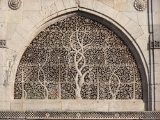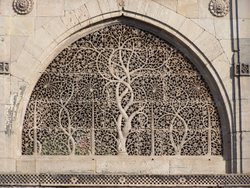
Sidi Saiyyed mosque
Encyclopedia

Ahmedabad
Ahmedabad also known as Karnavati is the largest city in Gujarat, India. It is the former capital of Gujarat and is also the judicial capital of Gujarat as the Gujarat High Court has its seat in Ahmedabad...
. As attested by the marble stone tablet fixed on the wall of the mosque, it was built by Sidi Saeed (or Sidi Saiyyed) an Abyssinian in the retinue of Bilal Jhajar Khan, general in the army of the last Sultan
Sultan
Sultan is a title with several historical meanings. Originally, it was an Arabic language abstract noun meaning "strength", "authority", "rulership", and "dictatorship", derived from the masdar سلطة , meaning "authority" or "power". Later, it came to be used as the title of certain rulers who...
Shams-ud-Din Muzaffar Shah III of the Gujarat Sultanate
Gujarat Sultanate
The Gujarat Sultanate was an independent kingdom established in the early 15th century in Gujarat. The founder of the ruling Muzaffarid dynasty, Zafar Khan was appointed as governor of Gujarat by Nasir-ud-Din Muhammad bin Tughluq IV in 1391, the ruler of the principal state in north India at the...
.
The mosque was built in the last year of the existence of Sultanate of Gujarat. The mosque is entirely arcuated and is famous for beautifully carved ten stone latticework
Latticework
Latticework is a framework consisting of a criss-crossed pattern of strips of building material, typically wood or metal. The design is created by crossing the strips to form a network...
windows (jali
Jali
A jali is the term for a perforated stone or latticed screen, usually with an ornamental pattern constructed through the use of calligraphy and geometry. Early work was performed by carving into stone, while the later more elegant used by the Mughals employed the technique of inlay, using marble...
s) on the side and rear arches. The rear wall is filled with square stone pierced panels in geometrical designs. The two bays flanking the central aisle have reticulated stone slabs carved in designs of intertwined trees and foliage and a palm motif. This intricately carved stone window is the Siddi Sayyed Jali, the unofficial symbol of city of Ahmedabad and the inspiration for the design of the logo of the Indian Institute of Management Ahmedabad
Indian Institute of Management Ahmedabad
The Indian Institute of Management Ahmedabad , better known as IIM Ahmedabad or simply IIM-A, is a business school located in Ahmedabad, Gujarat, India. It is the second Indian Institute of Management to be established, in 1961.-History:...
.
The central window arch of the mosque, where one would expect to see another intricate jali, is instead walled with stone. This is possibly because the mosque was not completed according to plan before the Mughals invaded Gujarat.

